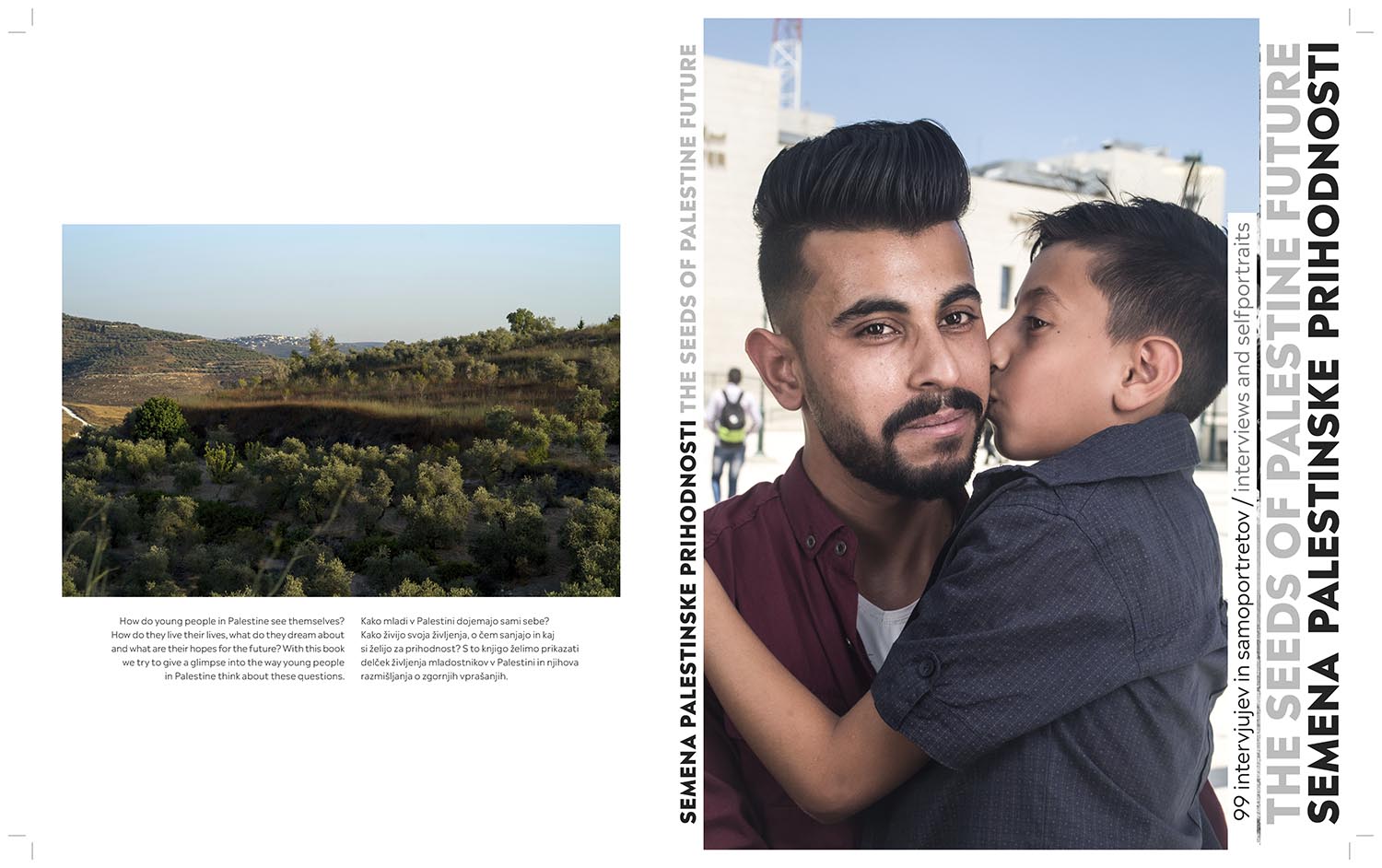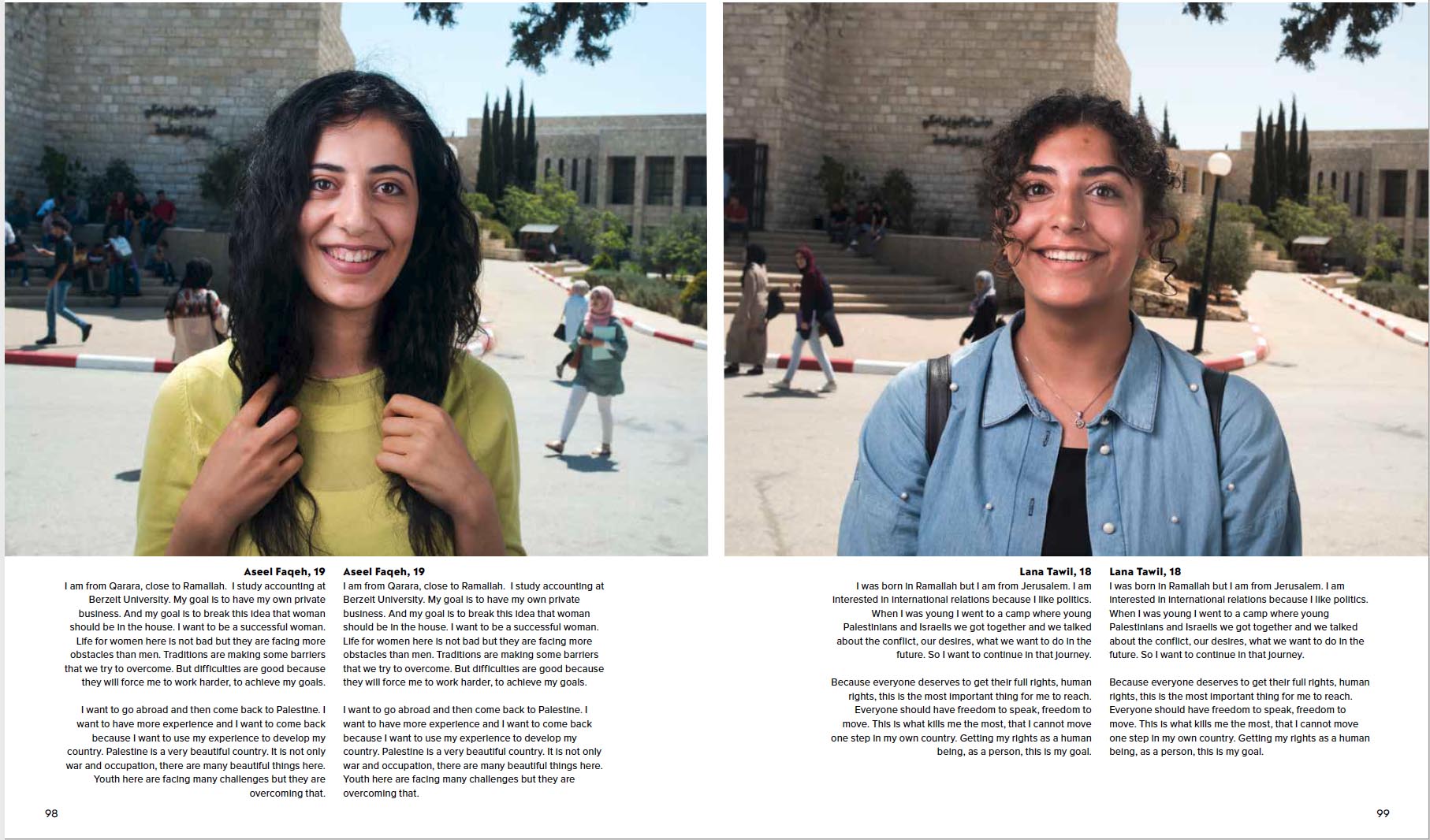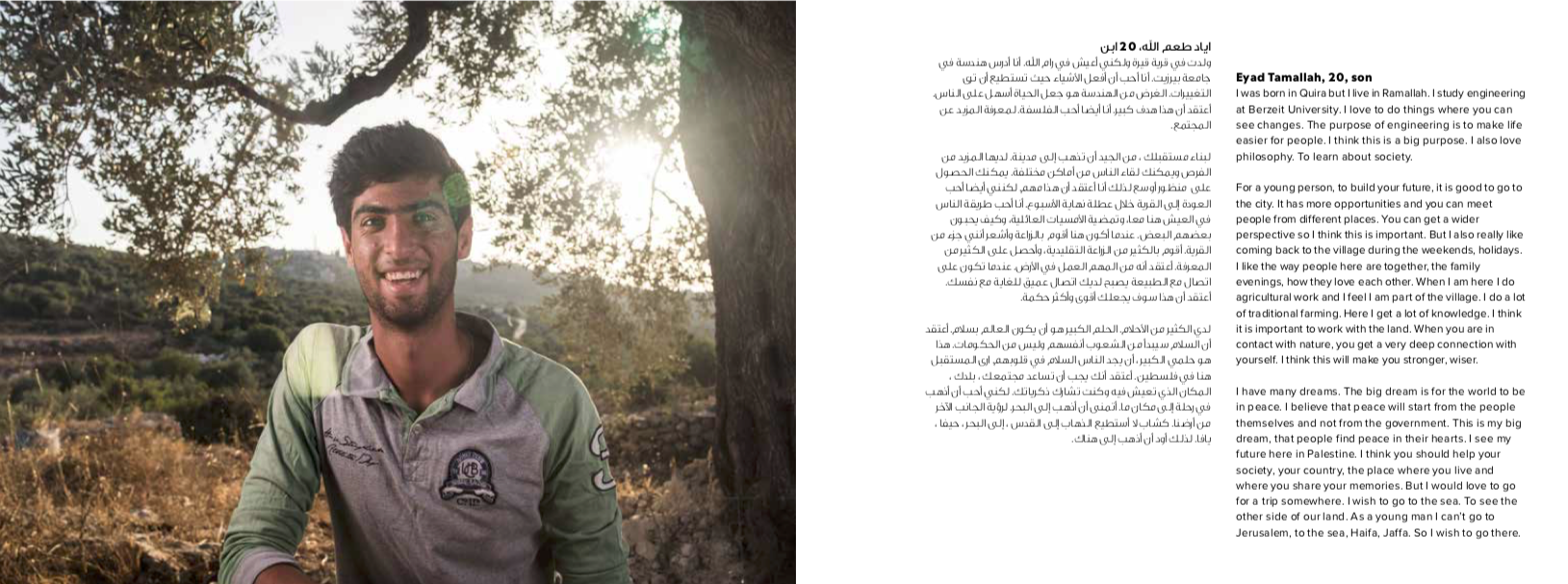SEEDS OF PALESTINE dreans, is the title of 2nd edition of a book, where 99 Palestinians expres in selfportrait and words, there relation with ladn of Palestine and people living there (previev 1st edition) Book -2nd, edition is on the short list, to be published by publisher Sanje



Eyad Tamallah, 20 ....I have many dreams. The big dream is for the world to be in peace. I believe that peace will start from the people themselves and not from the government...
I was born in Quira but I live in Ramallah. I study engineering at Birzeit University. I love to do things where you can see changes. The purpose of engineering is to make life easier for people. I think this is a big purpose. I also love philosophy. To learn about society. For a young person, to build your future, it is good to go to the city. It has more opportunities and you can meet people from different places. You can get a wider perspective so I think this is important. But I also really like coming back to the village during the weekends, holidays. I like the way people here are together, the family evenings, how they love each other. When I am here I do agricultural work and I feel I am part of the village. I do a lot of traditional farming. Here I get a lot of knowledge. I think it is important to work with the land. When you are in contact with nature, you get a very deep connection with yourself. I think this will make you stronger, wiser.
I have many dreams. The big dream is for the world to be in peace. I believe that peace will start from the people themselves and not from the government. This is my big dream, that people find peace in their hearts. I see my future here in Palestine. I think you should help your society, your country, the place where you live and where you share your memories. But I would love to go for a trip somewhere. I wish to go to the sea. To see the other side of our land. As a young man I can’t go to Jerusalem, to the sea, Haifa, Jaffa. So I wish to go there.
During 10 days in July 2018, anthropologist Barbara Vodopivec and me did 100+ interviews with selfportraits in the country of Palestine – cities and villages in the West Bank. The result is unique, nothing I could have imagined beforehand. It presents a parallel life, deeply rooted in heartfelt relationships between people, as well as to the land. Land as a space that provides everything necessary for life, as well as culture and history. The wisdom based on the intelligence of heart, which goes beyond unconscious survival patterns of human nature, is very valuable for everyone of us, because we are all to some extent exposed to the pressures of domination, exploitation, control, violence. It is the way to find a peaceful transition to the next step of our evolution in harmony with all beings.
At least half of the Palestinians are scattered around the world, but remain connected with the land and the people in Palestine. In this way, the wisdom they developed is also spreading around the world. The situation is similar to the side effect of the occupation of Tibet since 1950. More than half of the Tibetans live outside of Tibet, spreading Buddhist wisdom all over the world as an important mankind’s endeavor to understand life and develop peaceful ways of coexistence. It is based on compassion, which is also a common point with Palestinian wisdom. It lies in their hearts.
What also became clear to me during our time in Palestine is that Jewish people, through their centurieslong struggle for survival, developed extreme intellectual consciousness. The latter drives and motivates us “from the opposite side” to the intelligence of heart. To this day, these two fundamentally different worlds have not found a peaceful dialogue. When talking about the future, many of our Palestinian interlocutors stressed that the most important goal should be peaceful coexistence for ALL in Palestine, which also includes the settlers who took over the Palestinian land.
PALESTINIAN YOUTH AND SEEDS OF THE FUTURE
introduction from the book by Barbara Vodopivec, anthropologist, Society for Human Rights Humanitas, Slovenia
How do young people in Palestine see themselves? How do they live their lives, what do they dream about and what are their hopes for the future? With this book we try to give a glimpse into the way youngpeople in Palestine think about these questions. Thisis not a research about Palestinian youth or a holisticrepresentation of their lives. Rather, it is an artproject, a mosaic of images and a story about the way they understand themselves and the place andtime in which they live.
Through the use of self-portrait photography and short interviews we hope to capture young people’s voices, particularly their experience and expressionof a personal and collective identity. The portraits,which always place an individual against his or her background, explore identity from a very intimate, individual perspective but always in relation to thebroader environment. Personal and collectiveidentities are closely interconnected and in the narrative of the young people, the harsh politicaland economic situation further intertwines the two.When young people talk about their own lives theyalso talk about Palestine. When they describe their home they also describe their country. In theirnarrative Palestine is not something abstract but what they experience and express through their daily life – through work, dance, sport, studies, art,architecture, friendship, family. As many emphasize,due to the struggle for freedom and justice,Palestine is in everything they do. This means thatpersonal dreams are impossible to separate fromthe hopes and aspiration for a Palestinian future.
The portraits and interviews thus aim to tell a story of how young people feel their identity, how they experience it through their personal self as well as through the place in which they live, and in relationto people they live with, or are separated from. Forthe context of Palestine, the latter is particularly important, with Palestinians living divided betweenthe West Bank, Gaza, and the rest of the world. Thisseparation, together with the system of oppression, discrimination and colonization which makes it almost impossible for people to travel, creates a distance that many young people try to overcome in their imagination by pointing to their emotional attachment to places and people they have only heard about, either through friends, parents orgrandparents.
The people we met were outspoken about the way the political and social context they live in limits theirdreams and possibilities for the future. And the sadness and anger this causes. Yet they alsoexpressed an incredible perseverance, resilience andhopefulness. Despite insecurities that perpetuatetheir lives young people stress the importance oflooking forward and struggle for change. Their dreams and imagination of a different future are not to be excluded from this change.
All the photos are self-portraits. While thephotographer set up the photo studio it was thepeople themselves who took the portraits. This so called Selffish Studio developed by the Slovenianphotographer Bojan Brecelj enables people to express themselves in a creative way, making themnot only participants but co-authors of the project.
Every portrait was followed by a short interviewwhich is partially published together with the photo. The photo studio was set up on different locations – streets, universities, youth centres, parks, cafes.Aside from few exceptions most of the people wereselected randomly. Conversations took place in English or in Arabic with the help of a translator.
During our ten day stay in Palestine we visited East Jerusalem, Bethlehem, Nablus, Jenin, Ramallah andHebron, always with the surrounding areas. People wemet live in these cities for various reasons: some were born there while others moved to the area to work,study, or are only passing through. These mix of people with different personal backgrounds shows the flow of the cities and its interconnectedness, the mobility, which although limited, it is still taking place.
During our stay in Palestine we also planned to visit Gaza yet we were not able to obtain permission toenter. Unfortunately, we were also not able to meetPalestinians living inside the 1948 territory, the importance of which was stressed by several peoplewe met. Hopefully, this is something we will be able to do another time in the future.
Lastly, we would also like to mention that both authors of the publication are form Slovenia and donot live in Palestine. This of course had an impact onthe way we approached the project, on the set up ofthe studio, on the questions we asked and the final selection for the publication. Our voices are thus impossible to exclude from the publication. This istherefore not just a book about the way young people see themselves, but to a certain extent, it is also connected to the way we see lives of youngpeople in Palestine.
Intruduction to the 2'nd edition : (google translate from slo )
Hopefully this is something we will be able to do at some other time in the future, stated in the foreword to the first edition, because we were not able to get permission to enter Gaza to interview the young people as we were able to do in the West Bank ( the Jordan River) and in Jerusalem.
If I had not visited Palestine and Israel, it would have been an impossible mission for me to connect and understand this part of the world. Meetings and conversations with many people throughout the West Bank of occupied Palestine, who welcomed me with open arms, opened my eyes. So many years of constant oppression and aggression should make them miserable. But I experienced the opposite. The Palestinians showed us another side of (human) nature - I met proud and down-to-earth people whose self-confidence is based on trust in life itself. They managed to establish a parallel life, which they live together to the fullest. Order there is not based on obedience or survival, but on self-awareness, self-awareness that is not formally expressed. I could identify with this because, even though I was only a passing stranger, they welcomed me so warmly. A simple definition of coexistence among Palestinians in this part of the world has three pillars: a loving relationship with the land where they live; strong mutual relations or strong community; a deeply internalized consciousness of unity with a unique, invincible life. Many have expressed their dreams in interviews that one day there will be peace and harmony among the people currently living on this earth. Palestinians in Palestine - now in Gaza - know that many more can be killed, but that their spirit and the true nature they embody will eventually be part of a shared peaceful future. In a world where the consciousness of interconnectedness (unity) is a threat to many, the "parallel life model" mastered by the Palestinians, especially in Gaza for 75 years, the Lebanese with the experience of the thirteen-year war in Beirut, the Syrians and other Arabs in this part of the world , a common human experience that is spreading, as a large part of these families are displaced around the world - they live among us. at the same time, they remain connected to their original place and people. The awareness that it is possible to live fully, even as a parallel life, should not be just a dream for many around the world who do not agree to violence. In a world with such awareness, there will be no division between Palestinians and Israelis.




Project was exibited first time in Ljubljana /SLO/-Galerija Bolka - please connect us to the next place to exibit and netwoork on, bojan
